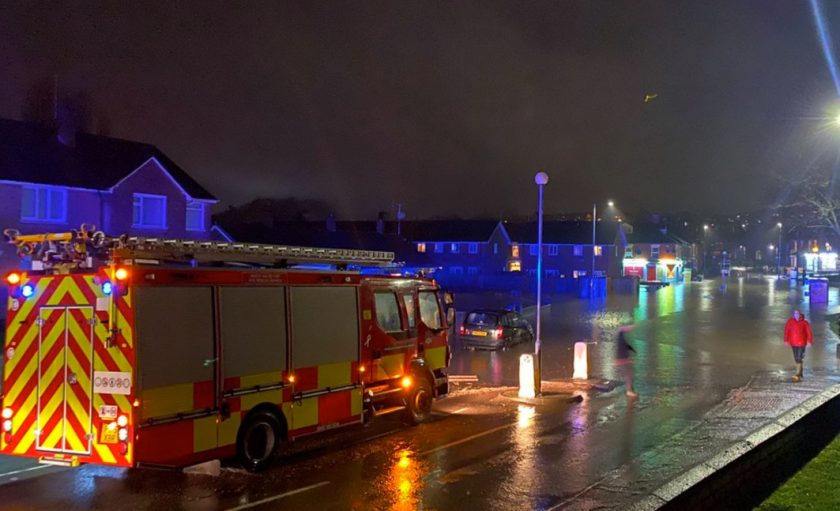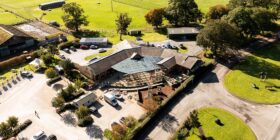Scrutiny to assess if ‘lessons learnt’ from Storm Christoph have been actioned by council

How Wrexham Council will respond to future adverse weather events and communicate with local councillors is set to scrutinised this week.
The local authority was asked to improve its work after it was agreed that communication problems were partly to blame for a slow recognition to the seriousness of Storm Christoph in January 2021.
A day of torrential rain on January 20 across Wrexham caused flash flooding and widespread disruption throughout the county borough.
Several areas were badly impacted the torrential rain, with homes evacuated in New Broughton, Bangor-on-Dee and Almere Farm, near Holt. Parts of Rossett and the Ceiriog Valley were also hit by flooding – with the heavy rainfall also causing a landslide in Newbridge.
A meeting in July 2021 revealed what was happening on the ground as councillors in the most affected areas highlighted a lack of communication with the local authority and how the late arrival of sandbags was like sending a lifeboat to the Titanic after it’s already sunk”.
Cllr Nigel Williams, Gwenfro ward, called on Wrexham Council to “identify mistakes” made and to “learn from them and try to improve” for any future flooding incidents.
Committee members agreed to a series of actions for the council to take on board and to ensure were in place, including:
ii) Review and improve communications with the Delta out of hours service
iii) Ask Welsh Government (WG) to fund the required works to the B5605 (Newbridge) from flooding relief support monies
iv) NRW and related parties to review existing community flood plans
v) Provide information on planned maintenance of highway gullies
vi) Clean and clear watercourse wherever possible
vii) Improve means of communication with flood wardens in the event of an emergency
viii) Hold a workshop on the role of local Members during an emergency
ix) That a progress report be considered by the Committee in January 2022
x) Explore the use of social media as an information resource in the event of emergencies
Tomorrow (Wednesday 19 January) members of the homes and and environment scrutiny committee will be asked to consider and comment on the council’s approach to “responding to and recovering from such flooding incidents and on the actions being taken to mitigate or prevent such severe flooding in the future”.
The report due before councillors (which can be viewed here) provides an update on the work that has taken place over the last six months to address the actions to improve the local authority’s response to adverse weather events.
One area that came under fire over the summer was the lack of communication, particularly over the Delta’ service provider who run call response systems for the council.
During July’s meeting it was accepted that improvements needed to be made going forward, with Lawrence Isted, chief officer planning and regulatory, stating: “I think it’s perfectly adequate for what it’s designed for, which is social care. But for this event, we might need to invent something of our own or do something different.”
In a bid to improve communication going forward, the report states: “The Chief Officer Social Care, whose department holds the contract with Delta, and the Chief Officer Environment & Technical have reviewed the specification of the current out of hours service provided by Delta.
“Officers have met with representatives of Delta to ensure existing service specification and performance indicators are managed robustly.
“A revised specification has also been developed and officers have commenced discussions with Delta to transition the service in accordance with this revised specification.
“In addition to the above, as part of our internal emergency response planning we have introduced a Bad Weather Response team. In the
event of a bad weather forecast or a period of prolonged adverse weather, an internal response team is ‘stood up’.
“This team consists primarily of volunteers from Environment & Technical Services with the local knowledge, expertise and experience to provide ‘intelligent control’.
“This provides dedicated telephone handlers allowing our operational supervisors to manage deployment of workforce and resources. In
addition, this will provide for regular information updates and communications on priority work areas, as well as updated and real-time weather warnings. The Bad Weather Response team was called in advance of the recent Storm Barra (7 December 2021).
“Officers staffed a local operations room in Abbey Road Depot between the hours of 09:00 and 19:00 providing dedicated telephone support to manage and respond to issues and reports of damage.
“The exercise proved extremely useful and provided support to our officers on the ground with the intelligence they needed.”
It was also proposed the council’s social media was used as a way to keep people informed in the event of emergencies.
The press and communications team are described as making “very extensive use of social media in its daily work and during emergencies.”
Local councillors who had been the main source of contact with their constituents during the storm had also called on lead members and senior officers to hold a workshop with them on their role during emergency responses.
After listening to comments from local members over the summer, Cllr David A Bithell, lead member for environment and transport, said: “I think we do need to prepare, we do need to learn the lessons with potentially how we communicate with elected members and how we communicate with members of the public in emergencies of this scale.”
As a result the report notes that “planning procedures are underway supported by the regional Emergency planning team (NWCREPS)” and that an “exercise to provide reassurance and engagement with elected members will be arranged in the next month or so, when the above
arrangements have been reviewed and updated (so as to give members information on the most up to date procedures).”
Concerns over communication issues with local flood wardens have also been addressed, with the report explaining that “contact information and local details shared and recorded and summary action cards devised to ensure all responders have ready access to critical emergency information.”
The clearing of gullies and drainage also faced criticism from councillors last year, with chief environment officer Darren Williams accepting that whilst there had been a “lapse” in maintenance in recent years, this is something that has been improved over the last 18 months.
He also explained that during periods of torrential rain and bad weather, “all the debris that it brings with it almost nullifies the gullies.”
Details of the planned maintenance of highway gullies and ordinary watercourses in Wednesday’s report, which explains that officers in environment and technical are entering the second full year of the new planned drainage cyclic programme of works.
The report states: “The council currently has 35,614 gullies installed on the public highway network and manages a significant number of smaller ‘ordinary’ watercourses.
“The planned cyclic programme targets each gulley to be visited, and importantly, treated within a 12 month period.
“In addition as part of our planned programme of improvements to drainage infrastructure, over 40 individual schemes were identified following the major flooding event earlier this year.
“The majority of these have been actioned and completed with remainder programmed for completion during the remainder of the year.
“Over the past two years a significant amount of resource has been put into populating and plotting road gullies from paper completion sheets that teams bring back to the office, with recent year’s weather conditions worsening the need to have more accurate data on the state of our assets is crucial.
“Officers are in the process of digitising our cyclic work on gulley cleansing and this will enable us to further increase productivity in areas of need and at the right times of the year.
“Our package combines mobile technology with Ordinance Survey Data to create a software product that will enable our teams to automate assets and risk as well as location. This be used to reduce risk of flooding to properties while being flexible to develop remedial works programmes.
“This is a mobile application that will allow users to add or download highway asset data whilst completing works onsite, in effect this will be similar to a remote desktop which will reduce on paper moving forward.”
The report will be debated by members of the homes and environment scrutiny committee at 2:30pm tomorrow, Wednesday 19 January.
As is now usual, members of the Committee will “formulate their conclusions and recommendations based on the information in the report and the discussions at the meeting”.
The meeting will also be webcast on the Wrexham Council website.
Spotted something? Got a story? Email [email protected]













